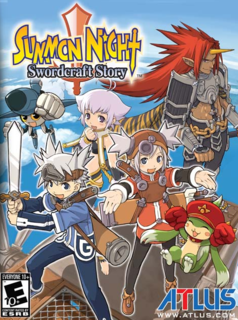Art and Swordscraft.
Swordcraft Story is essentially an old-school RPG that encompasses most of the ingredients that make the genre works. It has its share of random battles, dungeon-crawling and boss fights, as well as some tedious experiences in items collection. The incentives for collecting items, however, are perhaps more important than that of most other RPGs in the market right now. You see, in this game, you’re a Craftsman. This basically means that you make your own weapons instead of buying them. And to make them, you’d need materials. As a result, gathering items becomes the only way that you can forge or upgrade weapons. To make things more complicated, you’d also need to learn the different techniques in forging these weapons. It’s not uncommon, therefore, to find yourself spending a large amount of time learning techniques, and ploughing through dungeon levels in search of materials, just so that you can keep up with the more powerful enemies as you progress. This may sound drab in theory, but it actually turns out to be rather interesting simply because of the large amount of weapons (over 150) that you can forge. The game features five weapon categories: Sword, Axe, Spear, Knuckles and Drill. Each of these has their own strengths and weaknesses. Sword type weapons, for example, are fast-attacking tools, but the amount of damage dished out by them is comparatively lesser than those by Axe types. Axes, on the other hand, are very much slower to wield. Spears provide long range attacks at a slower pace, while Knuckles pack an explosive punch at the expense of reach. Drills are perhaps the most interesting category of the five, as its purpose is to wear down an opponent’s (usually a boss) weapons quickly. Breaking a boss’ weapon has a great bearing on your own arsenal, because you can learn his or her technique, and therefore forge the same weapon for your own use. You’d need these weapons too, because the enemies will become quite challenging as the game goes. As with most RPGs, the number of random battles in Swordcraft Story is annoyingly aplenty. However, early in the game, you’d get to partner a Summon Beast, who’ll act as a typical mage partner commonly found in other RPGs. The beast can add to your attacking prowess, heal your wounds, and help you guard enemies’ attack. These supporting powers, however, must be learnt as the beast levels up. So, apart from levelling up your own character, you may just find yourself fighting more often just to garner more supporting powers from your partner. Before a fight, you can assign your weapons into the various weapon slots (up to three initially) in your menu. During a battle, you can switch them on the run by simply pressing the L button. Similarly, the supports of your Summon Beasts can also be assigned (up to five), and cycled through during a fight using the R button. This switching feature encourages a more tactical approach than mere button-smashing, although it’s undermined by the fact that a high-stat drill can break almost any weapons. The battles in Swordcraft Story are also different from the turn-based affairs found in other RPGs. An action-style battle system is used here, which essentially allows you to attack your enemies in real-time. This is a refreshing change to the typical RPG approach, because it allows battles to finish quickly. On top of the usual health bar of the parties involved in a battle, you’ll also get to view the condition of the weapons used during a fight. If you manage to break a boss’ weapon, he or she loses by default - it’s not necessary to deplete his or her health completely. As mentioned earlier, breaking a boss’ weapon also allows you to learn the technique of forging that particular weapon. So, if you intend to forge all 150+ weapons in the game, you may have to spend more time upgrading your drills for maximum weapons-breaking effect. The game also attempts to up its difficulty level by limiting the number of save points throughout the game. You can only save at specific sword statues at various locations, which may frustrate players who prefer to play on the go. Thankfully, a “suspend” system is also in place to perform a one-time quick save of your current status. Once you retrieve a suspended game, however, the quick save is gone forever. The sword statues are therefore still your best bet for taking a rest from the game.
Swordcraft Story was first released in Japan almost three years ago. Understandably, its graphics look a little dated. The anime-styled drawings are also typical RPG fare – spiky-haired hero; dole-eyed girls and the likes. Nevertheless, it’s still an acceptable effort for the GBA, especially when the animated details on the fight scenes look explosive enough to generate some excitement. The music scores in the game are catchy, and blend with the in-game situations rather well. However, they do get dull after a while, mainly due to of a lack of selection. The sound effects are ok though, especially when used to complement the fight scenes.
Swordcraft Story may not be an epic RPG like the Final Fantasy series, but it’s a nice little game that should provide more than a quick-fix of RPG goodness. The need to forge your own weapons provides depth to the gameplay, and the real-time battles make random battles easier to swallow. Despite it’s relatively short story, additional dungeon levels that will be added after your first playthrough also add to the game’s value.

